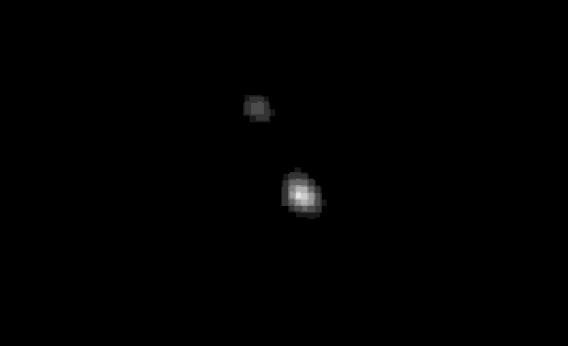Create a free profile to get unlimited access to exclusive videos, sweepstakes, and more!
Pluto, Unphased

On July 14, 2015, the New Horizons spacecraft will fly by Pluto, passing the surface by just a little over 12,000 kilometers.* This will be the first time in history we’ll have seen the little world and its moons close up, and I’ll be honest, the excitement is building.
A couple of weeks ago, the probe’s Long Range Reconnaissance Imager took a series of snapshots of Pluto and its big moon Charon, spanning about a week: the amount of time it takes the two to orbit each other. The images are amazing:
Note that both Pluto (the brighter one) and Charon (the dimmer one) are both moving. That’s because Charon has about 12 percent the mass of Pluto, which means that while Pluto’s gravity is pulling on it, Charon is pulling right back. So Charon makes a big circle around Pluto as it orbits, and Pluto makes a little one around Charon … or, to be technical, they both orbit their barycenter, their center of mass. I explain all that in an earlier post when this motion first became visible to New Horizons.
Note that the images here have been expanded a lot to make things easier to see; both objects look pixelated. When I first saw this animation, I was thrown for a moment: It looks like Pluto is half full, being lit more or less from the left. But I knew that couldn’t be right; it would mean New Horizons would have to be approaching Pluto from the side; with the Sun far off to the left in these images.
Pluto is 30 times farther from the Sun than Earth is, so I knew that the probe was heading toward Pluto with the Sun almost directly behind the spacecraft, not to the side. I figured I’d better see what’s what here, so the first thing I did was look up Pluto’s trajectory.
As you can see, I was right; New Horizons is heading almost directly away from the Sun. From its point of view, Pluto is nearly opposite the Sun in the sky, and so it sees a very nearly “full” Pluto, its face almost 100 percent illuminated. In fact, the probe won’t see an appreciable phase to Pluto until just hours before closest encounter, which occurs at 11:50 UTC on July 14.
So clearly, the fact that Pluto looks half-lit must be an illusion, just coincidence in this zoomed view. But just to be sure I dug a little deeper. Knowing Pluto’s size, the distance to it when the images were taken, and the resolution of LORRI, I calculate that Pluto is a mere two pixels across in the pictures! Clearly, it can’t be showing a half phase if it’s that tiny, so again it must just be that the random blobbiness of it when the image is expanded makes it look that way. Incidentally, it looks bigger than two pixels because of a quirk of optics; any very small source of light gets smeared out a bit due to diffraction.
When these pictures were taken, New Horizons was farther from Pluto than Earth is to the Sun. But it’s moving, screaming across space at 14 kilometers per second; assuming it takes you three minutes to read this entire post, New Horizons will have traveled 2,500 kilometers farther from Earth and closer to Pluto by the time you reach the end.
Pluto is only about 2,400 km across (smaller than our Moon), so it won’t look like much until just before the encounter. Roughly speaking, a bit more than a month out, in early June, it’ll be 10 pixels across. It’ll be 100 pixels across when New Horizons is four days away from closest encounter and about 5 million kilometers away, and will grow from there. Until then, we’ll just have to be happy with these blurry images.
But they won’t stay blurry for long. Soon, in just a few months now—after a voyage of more than nine years and 5 billion kilometers—New Horizons will finally show us Pluto’s face.
Correction, Feb. 20, 2015: This post originally misstated that the closest encounter is on Feb. 14, 2015, but it's actually July 14.














